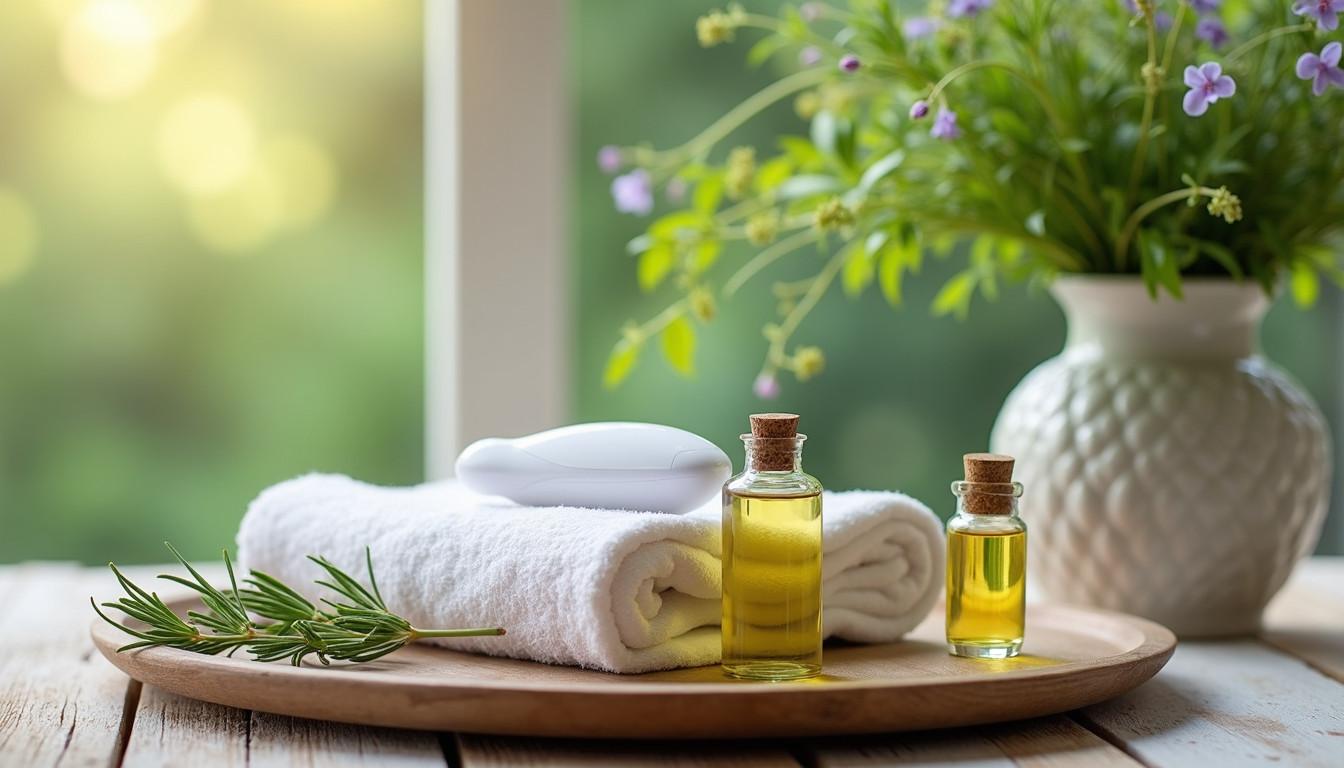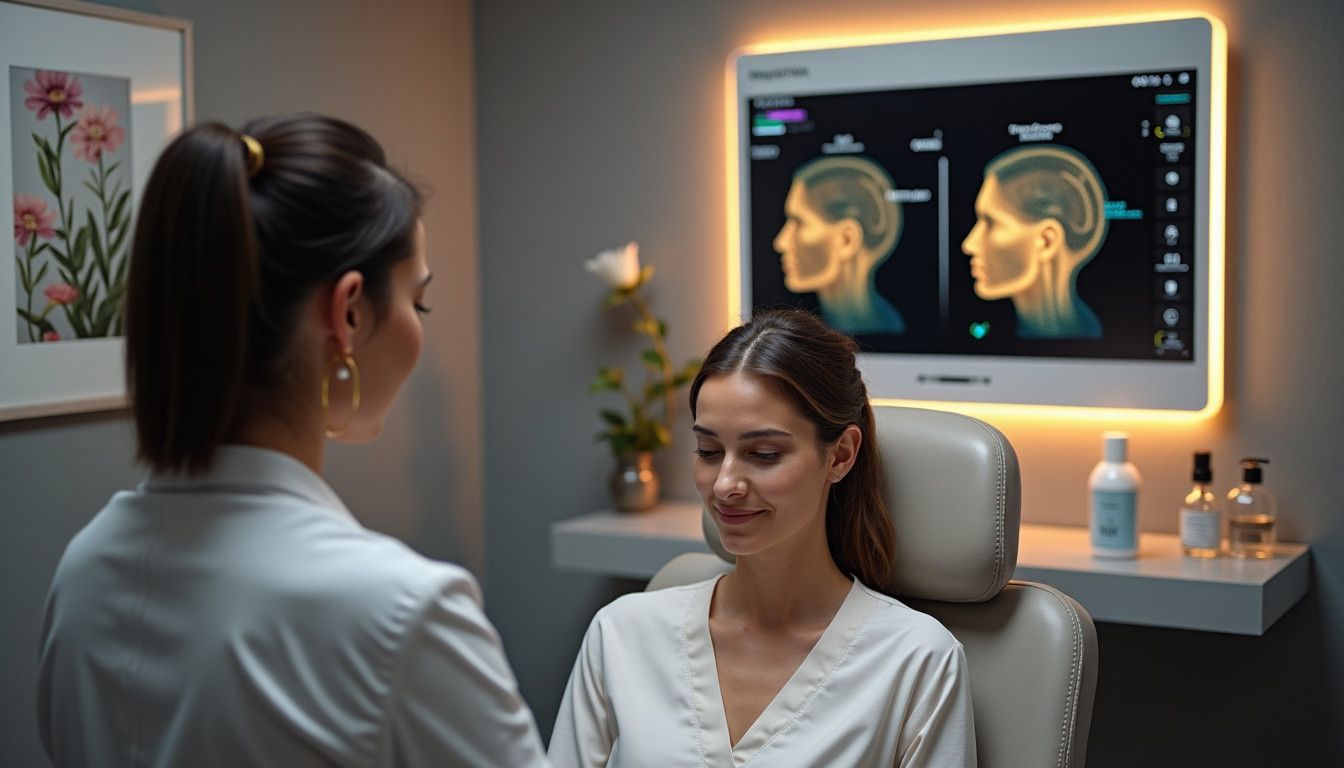At Glowskinhub.com, we believe beauty isn’t just a look—it’s a feeling

Stress Hair Loss Solutions: Regain Control of Your Hair & Health
Introduction:
Have you ever run your fingers through your hair and felt a little more come out than usual? Or maybe you’ve noticed more strands on your pillow, shower drain, or hairbrush? If you’ve been feeling overwhelmed or stressed out lately, this may not be a coincidence.
Hair loss is often assumed to be caused by aging, genetics, or poor Hair Care—but one of the most commonly overlooked reasons is stress. In today’s fast-paced world, where burnout has practically become a badge of honor, our bodies are paying the price—and our hair is one of the first areas to show it.
In fact, studies have shown that up to 45% of millennials actively search for stress-related hair loss solutions every month. That’s nearly half of an entire generation worried about something that many of us are told to “just ignore” or “not stress over.” But here’s the truth: stress-related hair loss is real, it’s common, and the good news is—it’s often reversible.
Why Is Stress Hair Loss So Common?
Modern life is full of stress triggers: demanding jobs, financial worries, social media pressure, family responsibilities, global events… it’s no wonder our bodies are constantly stuck in “fight or flight” mode. When we’re under chronic stress, the body diverts energy away from “non-essential” functions—like growing hair—and redirects it toward managing perceived threats. It’s a survival mechanism.
But for most of us, the threats are emotional, not physical—deadlines, conflict, insecurity—and they don’t just go away. This ongoing stress takes a toll on multiple systems in the body, including our hormones, immune system, and nervous system—all of which play key roles in healthy hair growth.
The Vicious Cycle of Stress and Hair Loss
If you’ve ever felt anxious about losing hair and then noticed even more coming out, you’re not imagining things. Stress and hair loss can create a vicious feedback loop. You’re stressed, which causes hair loss, which makes you more stressed—leading to even more shedding. Emotionally, it can feel incredibly defeating and isolating.
But here’s what’s important to remember: you’re not alone, and you’re not powerless.
Understanding how stress-related hair loss works is the first step to taking back control. With the right combination of natural remedies, self-care habits, nutritional support, and lifestyle changes, many people are able to not only stop excessive shedding but also regrow healthy, strong hair.
What You’ll Learn in This Guide
In this comprehensive post, we’re going to break down everything you need to know about stress-induced hair loss and, most importantly—what you can do about it. Here’s a quick preview of what we’ll cover:
- What happens inside your body when you’re stressed and how it affects your hair
- How to recognize the earliest signs of stress-related hair loss
- Natural ways to stimulate regrowth and strengthen your scalp
- Lifestyle changes that can reduce stress and support healthy follicles
- Professional treatment options and when to seek help
- How to cope emotionally and rebuild confidence during your hair recovery journey
Whether you’ve been dealing with stress hair loss for weeks or months—or you’re just starting to notice changes—this guide is designed to help you understand, heal, and grow stronger (both figuratively and literally).
Take a deep breath. Help is here—and your hair recovery starts now. 💚

1. Understanding the Science Behind Stress-Induced Hair Loss
Hair loss can be emotionally devastating, especially when it happens suddenly and without a clear reason. If you’ve noticed more hair on your pillow, in the shower drain, or thinning patches on your scalp, stress could be a major culprit. To truly tackle stress-related hair loss, it’s essential to first understand the science behind how emotional and physical stress impacts your hair cycle.
The Hair Growth Cycle Disrupted
Hair growth follows a well-defined cycle consisting of three main phases:
- Anagen (growth phase): Lasts 2–7 years, during which the hair grows actively.
- Catagen (transition phase): Lasts about 2–3 weeks, where hair stops growing and detaches from the blood supply.
- Telogen (resting/shedding phase): Lasts around 3 months, after which the hair falls out and the cycle restarts.
When you experience a major physical or emotional stressor—like surgery, a breakup, financial worries, or even chronic anxiety—your body may push a large number of hairs prematurely into the telogen phase. This condition is known as telogen effluvium, and it’s one of the most common types of stress-induced hair loss.
The Role of Cortisol
Cortisol, often called the “stress hormone,” is released by your adrenal glands in response to stress. While it’s helpful in short bursts—like when you need to escape danger—chronically elevated cortisol can wreak havoc on your entire system, including your hair.
Excess cortisol can:
- Suppress the function of the hair follicle
- Alter the hair growth cycle
- Trigger scalp inflammation
- Contribute to hormonal imbalances that affect hair health
In simple terms, your body views hair growth as non-essential during stress. It focuses instead on “survival” tasks like regulating blood pressure and managing glucose levels.
Chronic vs Acute Stress
- Acute stress refers to sudden, short-term stressors such as an argument or a deadline. This may cause some hair shedding but is usually reversible.
- Chronic stress, on the other hand, is the prolonged type—like constant work pressure or unresolved trauma—which can lead to persistent hair thinning over months or years.
Chronic stress doesn’t only affect hair density. It also influences hair quality. You may notice your strands becoming drier, more brittle, or prone to breakage. This is partly due to reduced blood flow to the scalp and nutrient absorption issues caused by stress.
The Emotional Toll
Hair is closely tied to our identity and confidence. Losing it unexpectedly can trigger even more anxiety, leading to a vicious cycle. Many people with stress-induced hair loss also report:
- Lowered self-esteem
- Social withdrawal
- Increased mental health challenges
Understanding that your hair loss has a biological explanation—not a personal failing—is a critical mindset shift. It allows you to approach the issue with empathy, not panic.
Key Takeaway
Stress doesn’t just affect your mind—it impacts your body on a cellular level, including your scalp and hair follicles. The good news is that stress-induced hair loss is usually reversible once the root cause (no pun intended!) is addressed.
By managing your stress levels and supporting your scalp and body with proper care, you can interrupt the cycle and promote regrowth. In the next section, we’ll look at how to recognize the early signs of stress-related hair loss before it gets out of hand.

2. Recognizing the Signs of Stress-Related Hair Loss
Stress-related hair loss often sneaks up on you. One day you’re brushing your hair like usual, and the next, your hairbrush is full of strands. The scariest part? It doesn’t happen immediately after the stressful event—so many people don’t even realize the two are connected.
Let’s break down the key signs that your hair loss may be linked to stress, not genetics or other causes.
🧍♀️Thinner Ponytail or Hair Clumps in the Shower
One of the earliest red flags is noticing a difference in hair volume. If your ponytail suddenly feels thinner, or if you need to wrap your hair tie around one more time than usual—that’s a classic sign of diffuse shedding.
You may also see more hair than normal:
- In your shower drain
- On your pillowcase
- On your clothes
- Or caught in your hairbrush
It’s normal to shed 50–100 hairs a day. But if you’re seeing clumps coming out or hundreds of strands daily, something’s off—and stress may be to blame.
🗓️ Delayed Timeline: 2–3 Months After the Stressful Event
Here’s where it gets tricky. Stress-related hair loss often lags behind the actual stress event by 2–3 months. That’s because the hair enters the telogen (resting) phase silently after a shock or trauma, then starts shedding weeks later when it exits that phase.
So if you went through:
- A breakup
- Job loss
- Illness
- Grief or trauma
- Or major burnout
… and are seeing unusual shedding months later, it’s likely connected.
This delay is exactly why stress hair loss often goes undiagnosed or misunderstood—it doesn’t feel “related” to the stress anymore. But the timeline tells a different story.
💇♀️ Texture Changes, Breakage & Dull Appearance
Hair affected by stress doesn’t just fall out—it also changes in quality. You might notice:
- Dryness or brittleness
- Frizz that wasn’t there before
- More split ends
- Hair that tangles easily
- Loss of natural shine or smoothness
This is because chronic stress deprives hair follicles of nutrients and hydration, making the hair more fragile. Even if you’re not losing handfuls of hair, these texture changes are a red flag your strands are suffering silently.
🧠 Itchy, Irritated, or Sensitive Scalp
Stress causes inflammation throughout the body—and that includes your scalp. You may experience:
- Tingling
- Burning
- Tightness
- Redness or flakiness
Some people even report a feeling of “sore” or “tender” hair roots. This sensitivity is linked to reduced blood flow, hormonal disruption, and inflammation—all common in stress responses.
If your scalp feels different but there’s no clear medical cause (like dandruff or dermatitis), stress could be the silent culprit.
😞 Emotional Symptoms That Go Hand-in-Hand
Hair loss rarely happens in isolation when stress is involved. You may also notice:
- Irritability
- Fatigue
- Anxiety or racing thoughts
- Trouble sleeping
- Feeling emotionally numb or overwhelmed
The emotional and physical are deeply connected. In fact, the hair loss itself can worsen the emotional toll, creating a vicious cycle of stress → hair loss → more stress → more hair loss.
Recognizing this pattern is powerful. It gives you the opportunity to step in early, seek support, and care for both your mind and your mane.
📝 Quick Self-Check: Are You Noticing…
✅ More hair fall 2–3 months after stress?
✅ A thinner ponytail or wider part?
✅ New hair texture problems?
✅ Scalp sensitivity or itching?
✅ Emotional burnout or anxiety?
If you answered “yes” to two or more, your hair loss is likely stress-related—and the good news is, it’s usually reversible with the right care and recovery plan.

3. Natural Solutions to Support Hair Regrowth
If you’re dealing with stress-related hair loss, your first instinct might be to panic—but don’t! One of the best things about this kind of hair fall is that it’s usually temporary. With the right natural, science-backed strategies, you can support your scalp and kickstart the regrowth process without reaching for harsh medications.
Here’s how to nurture your hair and body back to health, naturally.
🌀 Daily Scalp Massage
This simple ritual can make a huge difference. Scalp massage increases blood circulation, bringing more oxygen and nutrients to the hair follicles. When your scalp is under stress, circulation is often compromised—so giving it a little boost can help reverse that.
How to do it:
- Use your fingertips (not nails!) to massage your entire scalp.
- Move in gentle circular motions, starting at your temples and working toward the crown and back of your neck.
- Do this for at least 5 minutes daily.
Want to level it up? Try using a silicone scalp brush or massage with a nourishing oil blend like rosemary-infused coconut oil.
🌿 Essential Oils for Hair Regrowth
Essential oils can support hair growth and improve scalp health—naturally and without chemicals.
Here are 3 great options:
- Rosemary Oil: Promotes thicker hair and is as effective as minoxidil (a popular hair growth drug) in some studies.
- Peppermint Oil: Improves circulation and stimulates hair follicles.
- Lavender Oil: Soothes the scalp and reduces inflammation.
How to use:
- Mix 3–5 drops of essential oil with 1–2 tbsp of a carrier oil like jojoba, coconut, or argan oil.
- Massage into your scalp and leave it overnight—or wash after 30–60 minutes if preferred.
- Use 2–3 times a week for best results.
🥗 A Hair-Loving, Balanced Diet
What you eat directly affects your hair. During stress, your body uses nutrients to “survive” first—and hair growth takes a backseat. Replenishing those nutrients helps restore hair growth from the inside out.
Key nutrients to focus on:
| Nutrient | Why It Helps | Where to Find It |
| Protein | Hair is 90% keratin protein | Eggs, beans, lentils, tofu |
| Iron & Zinc | Supports follicles, prevents shedding | Spinach, pumpkin seeds, red meat |
| Omega-3s | Reduces inflammation, hydrates hair | Flaxseeds, walnuts, salmon |
| Vitamin A | Boosts cell turnover and sebum | Sweet potatoes, carrots |
| Biotin & B Vitamins | Strengthens hair shaft | Whole grains, avocados, nuts |
💧 And don’t forget hydration! Drink 2–3 liters of water daily to support scalp and Skin health.
🌙 Prioritize Sleep (Seriously!)
Your body does most of its healing during deep sleep, including cell repair and hormone balance. Chronic stress often leads to sleep disturbances, which in turn increase hair fall.
Tips for better sleep:
- Wind down with a warm shower or herbal tea.
- Turn off screens 30–60 minutes before bed.
- Try natural sleep aids like ashwagandha, magnesium, or chamomile.
- Stick to a regular sleep schedule—even on weekends.
Aim for 7–9 hours of uninterrupted sleep each night to give your hair the rest and repair time it needs.
🌿 Herbal Remedies & Adaptogens
Herbs have been used for centuries to combat stress and support hair health. Here are a few worth trying:
- Ashwagandha: Helps regulate cortisol and support adrenal glands.
- Ginseng: Boosts energy and hair follicle stimulation.
- Nettle Leaf: Rich in silica and iron for stronger hair.
- Hibiscus Tea: A favorite in Ayurveda for scalp nourishment and hair regrowth.
You can consume these in capsule form, teas, or tinctures. Just make sure to consult a healthcare provider if you’re taking medications or have health conditions.
🧘♀️ Reduce Stress, Naturally
Finally, don’t underestimate the power of daily stress relief practices. Even 10–15 minutes a day can break the stress-hair loss cycle.
Try:
- Deep breathing or meditation apps like Calm or Insight Timer
- Gentle yoga or stretching before bed
- Journaling or gratitude lists
- Spending time in nature
Hair regrowth starts from a calm mind and a nourished body—so be kind to yourself in the process.

4. Lifestyle Changes to Reduce Stress & Hair Fallout
Stress-related hair loss is not just a surface-level issue—it’s a full-body response to overwhelm. So if you want to stop the shedding and bring back your glow, you need to go beyond hair products. By making a few intentional lifestyle changes, you’ll not only support hair regrowth but also feel more energized, emotionally balanced, and in control.
Let’s walk through powerful habits that will reduce your stress levels and help your hair thrive again.
🧘♀️ Mindfulness & Meditation
You don’t need to sit cross-legged on a mountain for hours to get the benefits of mindfulness. Just 5–10 minutes a day of focused breathing or guided meditation can lower cortisol, improve focus, and soothe your nervous system.
How to start:
- Download a free app like Insight Timer, Headspace, or Calm.
- Try a body scan, where you slowly tune in to each part of your body while breathing deeply.
- Combine with soft background music or nature sounds to enhance relaxation.
Consistent practice over a few weeks can make a measurable difference in your mental clarity, sleep quality, and—you guessed it—hair health.
🧎♀️ Gentle Movement & Exercise
Exercising when you’re stressed may feel counterintuitive, but it’s one of the most effective ways to burn off excess cortisol and support healthy blood circulation to the scalp.
You don’t have to hit the gym. These low-impact options are perfect:
- Yoga – especially restorative or yin yoga to calm the body
- Walking in nature – 20–30 minutes daily can significantly reduce stress
- Dance or stretching – move your body in a way that feels joyful
Bonus: Exercise improves sleep, which is essential for reversing hair loss.
🛌 Improve Your Sleep Hygiene
We can’t stress this enough: Poor sleep = stressed body = hair shedding. When you’re sleep-deprived, your cortisol levels remain high, and your body has less energy for non-essential processes like hair growth.
To optimize your sleep:
- Stick to a schedule: Sleep and wake at the same time daily—even on weekends
- Power down electronics: Turn off screens at least 45 minutes before bed
- Cool, dark room: A sleep-friendly environment makes a big difference
- Wind-down routine: Try journaling, chamomile tea, or reading a paper book
If you wake up feeling groggy or wired at night, try natural supplements like magnesium glycinate or ashwagandha (consult your doctor if needed).
🍽️ Eat to De-Stress
Your food choices impact more than just your waistline—they influence your mood, energy, hormones, and hair.
Stress depletes essential nutrients, so it’s important to replenish with:
- Protein: Crucial for keratin production (eggs, tofu, Greek yogurt, lentils)
- Healthy fats: Omega-3s reduce inflammation (chia seeds, walnuts, salmon)
- Complex carbs: Help stabilize blood sugar and reduce anxiety (sweet potatoes, oats, quinoa)
- Magnesium-rich foods: Support relaxation and nerve health (spinach, almonds, bananas)
Also, cut back on caffeine, sugar, and alcohol during recovery. These may give temporary highs but often worsen anxiety and sleep.
🤳 Set Boundaries With Screens & Social Media
We often overlook how mental overstimulation from endless scrolling impacts stress levels. It not only steals your sleep but also elevates cortisol due to comparison, bad news, or general overwhelm.
Try these tech detox tips:
- Use apps like Forest or One Sec to reduce screen time
- Turn off notifications after 8 PM
- Designate screen-free zones—like your bedroom or dinner table
- Replace late-night scrolling with calming rituals (journaling, face massage, or listening to relaxing audio)
Giving your brain a break will reflect in your energy, mood, and scalp health.
💆♀️ Prioritize “Me Time” Without Guilt
Burnout is real—and it leads to hair shedding when your body is running on fumes. Schedule regular “me time” into your calendar like you would a work meeting.
Ideas include:
- 15 minutes of silence in the morning with tea
- An at-home spa night once a week
- Creative hobbies like drawing, gardening, or dancing
- Saying “no” to commitments that drain you
When you reclaim time to rest and recharge, your nervous system resets, and your hair thanks you.
✨ Progress, Not Perfection
Stress management isn’t about becoming perfectly Zen overnight—it’s about choosing small, sustainable actions that add up. Start with just one or two of these changes, and build from there.
Your hair journey is also a self-love journey. With each habit you develop, you’re sending your body the message:
“I’m safe. I’m supported. I’m healing.”

5. Proven Treatments & Therapies That Actually Work
Backed by science, supported by experience.
When you’re losing hair due to stress, it’s easy to feel powerless—but there are clinically proven treatments and holistic therapies that can truly help. Whether you’re looking for natural options, at-home solutions, or dermatologist-recommended treatments, this section will guide you through what actually works (and what’s just hype).
Let’s explore the real tools to support regrowth and restore your hair confidence.
🧴 1. Topical Minoxidil (Rogaine)
Minoxidil is one of the only FDA-approved treatments for hair regrowth in both men and women. It works by improving blood flow to the scalp and extending the growth phase (anagen) of hair follicles.
- Available in 2% and 5% solutions or foam
- Best applied once or twice daily on a dry scalp
- Visible results in 3–6 months with consistent use
💡 Pro Tip: It works best when started early. Don’t wait for major hair thinning before considering it.
⚠️ Note: Some people experience “shedding” in the first few weeks. That’s normal—it’s old hair making way for new growth.
💆♀️ 2. Scalp Microneedling
Microneedling (a.k.a. dermarolling) involves rolling a device with tiny needles over the scalp to:
- Stimulate blood circulation
- Trigger collagen production
- Improve absorption of topical treatments like minoxidil or natural oils
This boosts follicle activity and enhances regrowth over time. You can do it at home (using a 0.25–0.5 mm dermaroller) or book professional treatments.
🔒 Always sanitize your roller before and after each use to prevent infection.
🌿 3. Low-Level Laser Therapy (LLLT)
This treatment uses red light to stimulate energy production in hair follicle cells. It’s painless, non-invasive, and can be done at home using laser caps or combs.
Benefits include:
- Reduced inflammation
- Enhanced blood circulation
- Prolonged hair growth phase
Results are gradual, often noticeable in 4–6 months. It’s a solid option if you prefer non-chemical methods.
💊 4. Supplements & Vitamins for Hair Health
Stress drains your body of key nutrients. Replenishing them can supercharge your recovery:
- Biotin (Vitamin B7): Essential for keratin production
- Vitamin D3: Deficiency is strongly linked to hair thinning
- Iron + Ferritin: Especially crucial for women
- Zinc: Balances oil glands and supports follicle repair
- Collagen Peptides: Boost scalp elasticity and hair strength
Choose high-quality, third-party tested supplements, and pair them with a balanced diet. Look for formulas specifically labeled for “hair, Skin & nails.”
💉 5. Platelet-Rich Plasma (PRP) Therapy
PRP is a regenerative treatment where your own blood is drawn, processed, and injected into your scalp.
Why it works:
- Rich in growth factors that activate dormant follicles
- Increases scalp blood flow
- Promotes stronger, thicker hair strands
This is usually done in 3–4 monthly sessions, followed by maintenance. Though on the pricier side, it’s highly effective for telogen effluvium and early thinning.
🧪 6. Hormonal Testing & Treatment
If your stress is chronic or tied to hormone shifts (e.g. postpartum, PCOS, thyroid imbalances), blood testing can help.
Ask your doctor about checking:
- Cortisol
- Thyroid levels (TSH, T3, T4)
- Ferritin (iron storage)
- DHEA and testosterone (especially if acne + hair loss are present)
Addressing the root cause through medication, supplements, or lifestyle changes will ensure long-term results.
🌸 7. Ayurvedic & Natural Therapies
Prefer a holistic path? These traditional options are both gentle and effective:
- Bhringraj Oil: Known as the “king of hair” in Ayurveda, it improves hair density and darkens grays.
- Amla Oil: Rich in Vitamin C and antioxidants to strengthen roots
- Onion Juice: (Yes, really!) Packed with sulfur to stimulate dormant follicles
- Aromatherapy blends: Like rosemary, lavender, and peppermint oils
Use as weekly scalp massages or overnight masks. Just patch test first to avoid irritation.
⚖️ Consistency is Key
Hair grows slowly—about half an inch per month. Regardless of the method you choose, stick to it for at least 3 months before expecting major changes.
Also, remember that regrowth doesn’t always mean your hair will look exactly like it did before. But progress is progress—whether it’s baby hairs, less shedding, or improved texture.
✨ What NOT to Waste Time On
❌ Hair gummies with zero clinical backing
❌ “Miracle” oils with no ingredients list
❌ Harsh chemical shampoos full of sulfates
❌ Unregulated online pills promising fast hair growth
Your scalp is sacred—treat it with care, and it will return the favor.

6. Emotional Healing & Building Hair Confidence
Because recovery isn’t just physical—it’s emotional too.
Hair loss, especially when triggered by stress, isn’t just a cosmetic issue—it hits you emotionally and psychologically. Watching strands fall out day after day can create feelings of panic, sadness, and loss of self-esteem. You might find yourself avoiding mirrors, skipping outings, or obsessing over your appearance in photos.
But here’s the truth: you’re not alone, and your worth goes far beyond your hair.
Let’s dive into the emotional side of stress-related hair loss and how to rebuild your confidence—while your strands grow back.
💔 The Emotional Toll of Hair Loss
Stress-induced hair loss can feel like a double hit: the stress causes hair fall, and the hair fall creates more stress. Many people report feeling:
- Embarrassed in public or at work
- Disconnected from their appearance
- Anxious while washing, brushing, or styling their hair
- Frustrated with their body for “failing” them
- Hopeless after trying products that don’t seem to work
This can spiral into social withdrawal, low self-confidence, or even mild depression. And unfortunately, the Hair Care industry often makes it worse by promoting “perfect” hair as the standard of Beauty.
But here’s what you must remember: this is temporary, and healing begins from the inside out.
🧘♀️ Mind-Body Practices to Calm the Nervous System
To truly heal your hair, you have to address the root cause—your stress. These daily habits can soothe your mind and help lower cortisol levels:
- Meditation or Deep Breathing: Just 10 minutes daily can calm your nervous system and reduce cortisol production. Try guided meditations focused on healing or self-love.
- Gentle Movement: Yoga, walking, or stretching can release stored tension from the body. Aim for 30 minutes a day.
- Journaling: Writing out your thoughts helps you process and release negative self-talk. Try prompts like:
- “How does my hair loss make me feel?”
- “What can I control right now?”
- “What do I love about myself today?”
When your mind calms, your body follows—and your hair will thank you for it.
🧠 Cognitive Shifts That Support Confidence
How you think about your hair loss shapes your entire experience. Reframing your thoughts can make a massive difference in how you feel every day:
| Unhelpful Thought | Empowered Reframe |
| “Everyone will notice my thinning hair.” | “People are focused on themselves—not my scalp.” |
| “I’m not attractive without thick hair.” | “My Beauty comes from my energy, not my hair volume.” |
| “It’s hopeless.” | “This is temporary. I’m healing every day.” |
Practice these reframes often, especially when you find yourself spiraling into negative thoughts.
💇♀️ Style Your Way to Confidence (Even While Rebuilding)
Just because your hair is thinner doesn’t mean you can’t look and feel great right now. Small styling changes can lift your confidence immediately:
- Use volumizing dry shampoo at the roots for a fuller look
- Try side parts or soft waves to disguise thinning
- Rock scarves, hats, or turbans—they’re stylish and protective
- Explore shorter cuts that create the illusion of density
- Don’t be afraid to try clip-in toppers or wigs—they’re empowering tools, not a sign of defeat
Remember, these aren’t to “hide” anything—they’re to celebrate your Beauty in a way that feels good.
👭 Build a Support Circle
Hair loss can feel isolating, but you are not alone. There are thousands of others going through the same journey.
- Join Facebook groups or online forums focused on stress-related hair loss
- Follow creators on social media who speak honestly about their experience
- Talk to trusted friends or family about how you’re feeling
- Consider therapy or counseling if the emotional weight becomes too heavy
Connection is healing. Don’t suffer in silence.
✨ Affirm Your Identity Beyond Hair
Your hair may be a part of you—but it is not all of you. You are:
- A kind person
- A brilliant thinker
- A good friend or sibling or partner
- Someone with dreams, passions, and a journey ahead
Hair loss doesn’t define you—it refines you. It teaches strength, patience, and self-love.
Start telling yourself this daily:
“I am healing. I am growing. I am enough.”
7. Prevention Tips to Protect Your Hair from Future Stress Episodes
Once you’ve experienced stress-related hair loss, it’s natural to want to prevent it from ever happening again. The good news? You absolutely can. By making intentional lifestyle and Hair Care adjustments, you can protect your strands—and your sanity—against future flare-ups.
Let’s explore powerful, science-backed ways to safeguard your hair during stressful times.
🧘 Prioritize Stress Management Daily
Even if life feels busy, setting aside time to de-stress can literally protect your follicles.
- Daily breathing exercises: Try box breathing (inhale for 4 seconds, hold for 4, exhale for 4, hold for 4).
- Mini breaks: Step away from your phone and take a walk, sit in nature, or listen to calming music.
- Sleep hygiene: Go to bed at the same time every night, avoid screens 1 hour before bed, and keep your room cool and dark.
Preventing chronic cortisol spikes helps preserve your hair growth cycle.
🍽️ Eat Hair-Loving Foods Consistently
Your follicles thrive on nutrients. Make your diet rich in:
- Protein: Eggs, fish, lentils, and Greek yogurt
- Iron & Zinc: Spinach, chickpeas, pumpkin seeds
- Omega-3s: Walnuts, chia seeds, salmon
- Biotin & B vitamins: Sweet potatoes, oats, avocados
Avoid skipping meals—even stress can’t be starved away. Balanced nutrition keeps both your body and hair strong.
🧴 Create a Scalp-Care Routine
Your scalp is the soil for your hair. Treat it well!
- Massage with oil 2–3 times a week to boost circulation
- Use gentle, sulfate-free shampoos
- Don’t overwash—2–3 times a week is enough for most hair types
- Exfoliate monthly with a scalp scrub to remove buildup
A healthy scalp = strong, resilient hair.
🛑 Reduce Physical Hair Stress
Even styling can trigger unnecessary shedding:
- Avoid tight ponytails, braids, or buns that pull on roots
- Don’t brush aggressively—use a wide-tooth comb
- Air dry whenever possible; minimize heat tools
- Sleep on a silk or satin pillowcase to reduce friction and breakage
Think of your hair as fragile silk—the gentler your handling, the better it’ll thrive.
📅 Monitor Your Mental & Physical Health
Hair loss is often a sign of internal imbalance. Stay proactive by:
- Tracking your stress levels in a journal or app
- Getting regular blood work to check for deficiencies
- Visiting a trichologist or dermatologist at the first signs of unusual shedding
Early action can stop hair loss before it spirals.
8. Professional Treatments That Work
If you’ve tried lifestyle changes and natural remedies but are still dealing with persistent hair loss, it might be time to seek professional help. The good news is that the Hair Care industry now offers a wide range of scientifically backed treatments designed to target stress-induced hair loss from multiple angles.
Let’s explore the most effective professional treatments—from dermatological solutions to cutting-edge technologies—that can restore hair growth and strengthen follicles.
🩺 Scalp Microneedling (Dermarolling)
Microneedling uses tiny needles to create micro-injuries in the scalp, stimulating collagen production and increasing blood flow to hair follicles. This process encourages new hair growth by “waking up” dormant follicles.
- Often combined with topical serums (like minoxidil or peptides) for enhanced absorption
- Performed in clinics or at home with a 0.5mm–1.5mm dermaroller (under professional guidance)
💡 Ideal for: Early-stage thinning or diffuse hair loss caused by stress
⚠️ Not ideal for: Severely inflamed or infected scalps
💉 PRP Therapy (Platelet-Rich Plasma)
PRP has become one of the most popular hair restoration treatments in recent years. It involves drawing a small amount of your blood, processing it to concentrate the growth factors, and injecting it back into your scalp.
- Boosts follicle function and stimulates new growth
- Often administered in 3–6 sessions spaced a month apart
💡 Ideal for: Individuals with telogen effluvium or androgenetic alopecia worsened by stress
📈 Studies show up to 30–40% improvement in hair density after PRP therapy
💊 Prescription Topicals and Medications
Your dermatologist may suggest the following:
- Minoxidil (Rogaine): A topical solution that increases blood flow and prolongs the anagen (growth) phase of hair
- Finasteride (for men): A DHT-blocking oral medication that can reduce shedding
- Spironolactone (for women): A hormonal balancer for androgen-related hair loss
These are particularly helpful when stress is exacerbating a genetic condition like pattern baldness.
🔬 Low-Level Laser Therapy (LLLT)
This non-invasive treatment uses red light to stimulate hair follicles and improve cell metabolism.
- Available in clinic settings and in FDA-approved home devices (helmets, combs, caps)
- Requires consistency (2–3 times per week) for noticeable results
💡 Bonus: Also improves scalp circulation and reduces inflammation
🧴 Customized Scalp Treatments at Clinics
Advanced hair clinics offer deep-cleansing treatments that detoxify the scalp, balance oil production, and boost nutrient absorption.
- Exfoliating scrubs, LED therapy, massage, and Serum infusions
- Often combined with trichologist analysis for tailored treatment
Think of it like a facial for your scalp—except focused on growth, not glow!
🧪 Blood Testing & Nutrient Profiling
If your stress hair loss is connected to nutritional deficiencies or hormonal imbalances, blood testing can pinpoint the exact issue.
Common deficiencies linked to hair thinning:
- Iron
- Ferritin
- Vitamin D
- Zinc
- B-complex vitamins
Once identified, your doctor may prescribe targeted supplements or hormone therapy.
👩⚕️ When to See a Dermatologist or Trichologist
If:
- Hair loss continues for more than 6 months
- Your scalp is inflamed, itchy, or painful
- You’re seeing bald patches or losing eyebrow/lash hair
- You’ve tried over-the-counter treatments with no success
Then it’s time to consult a board-certified dermatologist or trichologist (a hair and scalp specialist). They can help you create a custom treatment plan based on your history and scalp condition.
Frequently Asked Questions (FAQ)
❓ Q1: How long does stress-related hair loss last?
A: Stress-related hair loss, such as telogen effluvium, usually lasts between 3 to 6 months after the initial trigger. Hair often begins to regrow once the underlying stress is managed, though full recovery can take up to 9–12 months depending on the severity and your body’s healing pace.
❓ Q2: Will all my lost hair grow back?
A: In most cases, yes! If the cause was temporary stress and not due to an underlying medical condition or genetic pattern baldness, your hair is likely to grow back with proper care, nutrition, and lifestyle adjustments. Patience and consistency are key.
❓ Q3: Can I stop stress hair loss instantly?
A: Unfortunately, there’s no instant fix. Hair growth follows a cycle, and stress disrupts it. You can’t stop the shedding immediately, but you can start supporting regrowth right away by managing stress, improving sleep, using scalp treatments, and nourishing your body.
❓ Q4: What are the best treatments for stress hair loss?
A: The best treatments include:
- Scalp massages to improve circulation
- Essential oils (like rosemary or peppermint)
- Adaptogens like Ashwagandha or Reishi
- Balanced diet rich in iron, zinc, and protein
- Stress management techniques like yoga, meditation, and therapy
Some also find topical minoxidil (Rogaine) helpful, but always consult a doctor first.
❓ Q5: How do I know if my hair loss is from stress and not something else?
A: Stress-related hair loss is often diffuse (all over the scalp), not in patches. It typically starts 2–3 months after a major stressor (like illness, breakup, job loss, etc.). If you’re unsure, a dermatologist can perform a pull test and blood work to rule out nutrient deficiencies or hormonal imbalances.
❓ Q6: Can anxiety and depression cause hair loss too?
A: Yes, they can. Chronic anxiety and depression increase cortisol levels and disrupt sleep, appetite, and hormonal balance—all of which affect hair health. Treating your mental health is just as important as treating your scalp.
❓ Q7: Is it safe to use hair products like dry shampoo or heat tools during this phase?
A: It’s best to limit the use of dry shampoo, heat styling tools, or chemical treatments while your scalp is recovering. Focus on gentle, nourishing care, and avoid tight hairstyles that can cause tension and further breakage.
❓ Q8: Can I dye my hair during stress-related hair loss?
A: If your hair and scalp are already fragile, it’s a good idea to hold off on coloring or bleaching until your hair starts to strengthen again. If you must color, opt for ammonia-free, gentle dyes and consult a professional stylist.
❓ Q9: Should I take biotin or hair supplements?
A: Biotin helps if you’re deficient, but it’s not a miracle solution for everyone. Look for multinutrient supplements specifically formulated for hair (with iron, zinc, B12, vitamin D, etc.). Always check with a healthcare provider before starting supplements.
❓ Q10: How do I stay hopeful when I’m losing confidence?
A: Start by remembering: this is temporary and treatable. Your hair doesn’t define you. Focus on self-care, gratitude, and healing routines—whether it’s journaling, trying a new hairstyle, or sharing your journey. Small wins every day add up to big progress.








